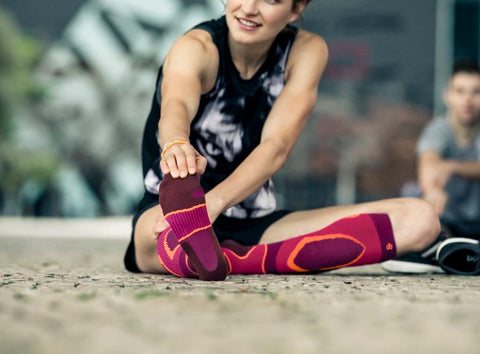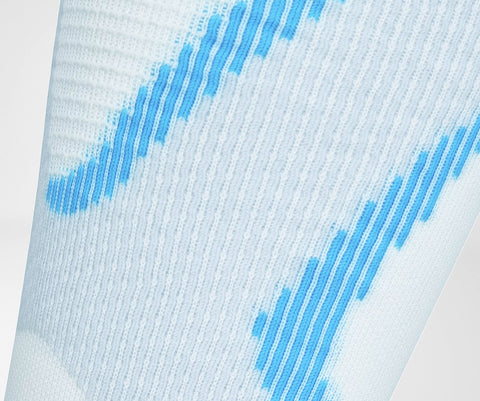Extra support
Soccer cleats are usually quite flat in the soles, so getting socks with additional support for key problem areas is a good idea. Depending on your foot, this may include arch support, ribbing around the ankle, extra heel cushioning, and/or Achilles protection.
Fortunately, quality sports compression socks like our Performance Socks incorporate these and more to help relieve irritation and pressure. With such protections, you can play longer with less risk of injuries like Achilles tendonitis and plantar fasciitis.
Note: you might also want a pair of socks with texture on the outer sole so your foot doesn’t slide around as much in the cleat.

Performance Socks Full-Length
Length
Soccer socks generally come knee-length or crew-cut to protect the ankle skin from cleat blisters. You can wear whatever length you prefer unless you’re training or playing in shin guards inside the socks. In this case, knee-high socks will be necessary to keep the guards secure during the game.
However, If you’d prefer shorter socks, there are shin guard varieties with durable straps or their own attached calf sleeve.
Material
When picking out your socks, material composition is essential. It can mean the difference between swampy, blistered feet and a comfortable game. Most athletic socks blend natural, synthetic, or natural and synthetic fibres. These include:
Cotton: while soft and breathable, cotton is notoriously good at retaining moisture. So while it’s a perfectly fine material for a shirt or even regular socks, it’s not a good fit for soccer socks. It’s also not very stretchy, meaning squeezing in a pair of shin guards will be difficult.
Merino wool: merino wool is a much better alternative to cotton, though it can be expensive. It’s soft to wear, sits flatter than other wool alternatives, and can absorb up to 3x its weight in water before feeling wet.
Synthetics: materials like polyamide, polyester, nylon, and elastane are often mixed in with natural fibres or used on their own. They offer a lot of stretchiness and can also get quite thin while remaining highly durable, making them great for tight cleats and intense games.
Our Sports Performance Socks, for instance, use a blend of Polyamide (87%) and Elastane (13%). This material composition offers:
- High elasticity
- Very soft texture
- Breathability
- Moisture-wicking properties. Moisture build-up can lead to blisters in the short term and some gnarly conditions like Athletes Foot if it’s left unchecked.
- Slim, highly tear-resistant fit
- Easy to wash and quick to dry. If you play recreationally, this shouldn’t be much of a concern. But if you start playing competitively, you’ll be surprised how many pairs and wash cycles you need.
- Minimal heat retention (great for summer and challenging training sessions, but it may be a bit chilly for slower winter games).
Learn more: Find out how quality material impacts the effectiveness of bracing and compression
Compression

Compression knit fabric is also a good thing to look out for when sock shopping. Sports Compression Socks help:
- Reduce muscle fatigue. Compression activates your muscles more efficiently and boosts circulation, supplying muscle tissue with oxygen and nutrients faster.
- Reduce muscle oscillation. These uncomfortable vibrations shoot up your leg when your foot hits the ground. While they may not seem so bad, oscillations lead to minor muscle damage that stacks up over time, leading to repetitive stress injuries like shin splints.
- Improve proprioception. Since compression fabric communicates with muscle fibres to help them send messages along the nerves to the brain, you’ll benefit from better bodily ‘awareness.’ Your muscles will work to better position your foot and stabilise the ankle as you run, kick, and manoeuvre on the field.
Do keep in mind, however, that not every compression sock is made equal.
Seams
While some traction in the sole is good, too many seams (especially if they’re ridged or not very well hidden in the fabric) can run against your foot too much. The friction can result in skin irritation and painful blisters that throw you off your game or take you off the field for a few days while they heal.
Fit
Last but certainly not least, you’ll need socks that fit you well. While you can get away with one-size-fits-several sock packs in daily life, athletic socks with compression knit and built-in foot supports are much more finicky.
Compression knit fabric needs to fit your leg just so. Too loose and it won’t work, too tight and it will hinder circulation instead of boosting it. Foot supports must also be appropriately positioned to protect the areas they’re made for. With such socks, you’ll also typically see a left foot and right foot marker for this very reason.
Learn more: #SizeMatters: How to find your perfect size and fit for Bauerfeind Braces
Bauerfeind socks get the tick of approval from Aussie soccer player Teigan Allen
To sum up
Your soccer socks of choice will ultimately come down to personal preference. But to better inform your buying decision, there are some things to keep in mind. A sock with good, breathable materials, proper fit, compression fabric, and foot supports can be the perfect addition to your soccer training and games. While one without can start negatively affecting your foot health and performance.
Check out more soccer supports: Soccer Supports & Braces





















